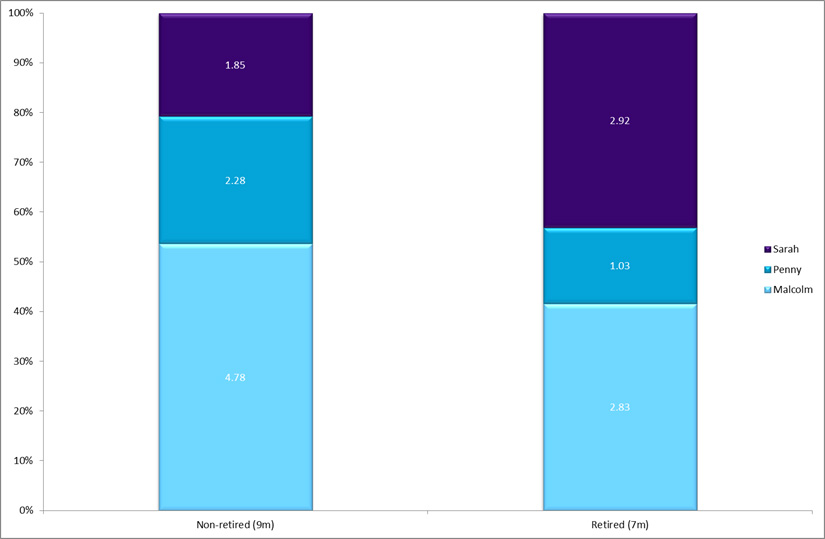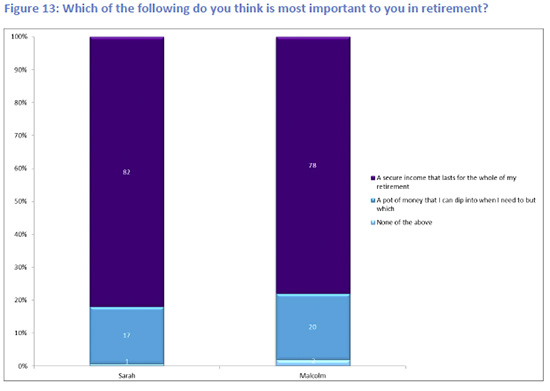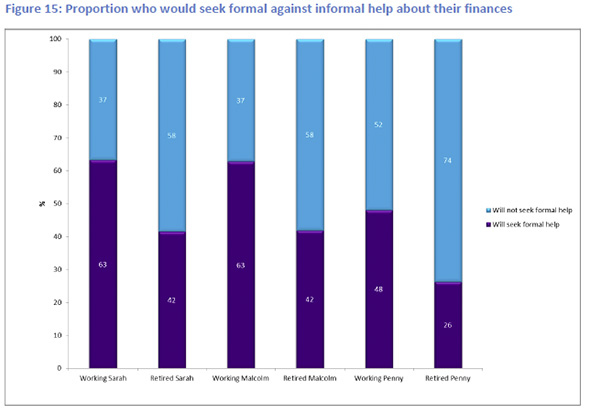We've been talking about it for nigh on a year now, but a report released by the NAPF today paints a detailed portrait of the decision-making paralysis facing many in the 50-70 age group at retirement.
'The Unpredictability of Retirement' surveyed more than 1,200 of these baby-boomers in the latter half of 2014 to find out how pension changes – freedom and choice, shifts in state pension age, and the decline of defined benefit pension schemes – have affected their journey towards or during retirement.
It cheerfully segmented them into three alliterative characters:
'Satisfied Sarah', retiring early with full DB pension, a homeowner with paid-off mortgage and very unlikely to have to work in retirement;
'Malcolm in the Middle', who has a mixture of defined contribution pension and other savings, would have liked to have retired at or before the state pension age, homeowner but still has some mortgage to pay off, facing drop in living standards if he retires fully; and
'Pinched Penny', a factory worker retiring on state pension only at SPA, expects retirement to be hard but no harder than life has been leading up to it.
'The Unpredictability of Retirement' surveyed more than 1,200 of these baby-boomers in the latter half of 2014 to find out how pension changes – freedom and choice, shifts in state pension age, and the decline of defined benefit pension schemes – have affected their journey towards or during retirement.
It cheerfully segmented them into three alliterative characters:
'Satisfied Sarah', retiring early with full DB pension, a homeowner with paid-off mortgage and very unlikely to have to work in retirement;
'Malcolm in the Middle', who has a mixture of defined contribution pension and other savings, would have liked to have retired at or before the state pension age, homeowner but still has some mortgage to pay off, facing drop in living standards if he retires fully; and
'Pinched Penny', a factory worker retiring on state pension only at SPA, expects retirement to be hard but no harder than life has been leading up to it.
Of those respondents still working, the Malcolms – the lightest blue bar in the graphs below – make up the biggest cohort at around 4.8m. All graphs are grabbed from the NAPF report.

Malcolms in the (squeezed) Middle...
We can almost immediately see that the narrative of the report is one of managing expectations – in turn hopefully leading to individuals choosing appropriate pathways to reach better outcomes.
The report said in general Malcolms expected to have to cut back a bit but not to struggle to make ends meet. But is intervention too little too late for these poor Malcolms, who make up around half of those yet to retire in this group? The recent reforms have created a great deal of uncertainty, sending any retirement planning into a tailspin.
The report said: "There is far less clarity on the choices they should make and on the returns they may get, making the whole experience less clear. The speed of pension reform, coupled with the economic crisis appears to be heightening these concerns. Furthermore, the shift from DB to DC is exposing a greater proportion of the retiring population to these uncertainties."
The report continues to outline what savers will need to help them navigate this new market, which include guidance, clearly defined pathways for those in DC, and easy-to-understand, good-value products.
The NAPF stops short of telling the market what it ought to design. But it does point to people's preference for a secure income – regardless of whether they're a Sarah, Malcolm or Penny – being at odds with attitudes towards annuities, which is a dirty word for many.
Don't mention the 'A' word...
A vast majority of both the Malcolms and Sarahs favoured a secure income that lasts for the whole of their retirement (the purple bar) rather than a pot of money to dip into when required (the darker blue).

But is it possible to create some kind of default around annuities? Or would we even want to?
At a conference last week, the Centre for Policy Studies' Michael Johnson mooted the idea of "auto-annuitisation" forming part of the decumulation solution – a proposal he promised to outline in greater detail within the next week or so.
But pensions minister Steve Webb, also at the event, dismissed the proposal immediately, declaring it a "terrible idea" that went against notions of choice, on the basis that everyone's needs are different.
The NAPF takes the stance that the answer lies not wholly in specific products, but in helping people make crucial financial decisions – or, as it says, designing simple "pathways" for members to follow.
Working Malcolms/Sarahs most likely to seek formal help
Two in three working Sarahs and Malcolms – so those with full DB or a mixture of DC and other entitlements – are likely to seek formal rather than informal help about their finances.

Introducing decision pathways makes a great deal of sense and will help people cut out the noise from options that simply are not relevant to them.
This will be followed by by the government's guidance service as a further line of defence, which will hopefully be a more meaningful conversation and a sense check for those about to commit to a product.
The NAPF's Graham Vidler said at the launch of the report on Tuesday: "Pathways are not a defaults in the purest sense as they would require some engagement from savers."
But at what point and where in a member's savings journey a simplified decision tree is introduced will be key.
Many current Malcolms might miss the boat, but it could be a workable and cost-effective port of call for the next generation of DC savers.














